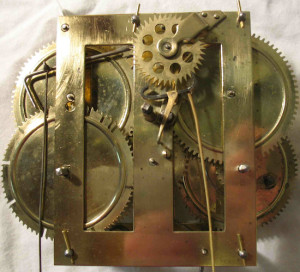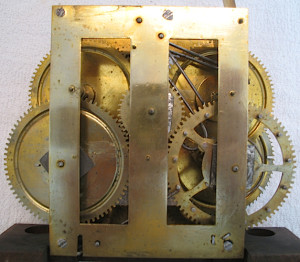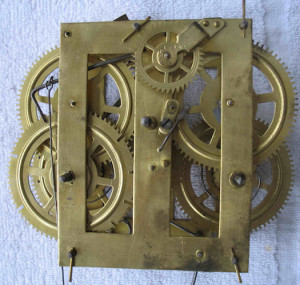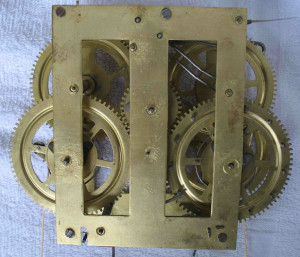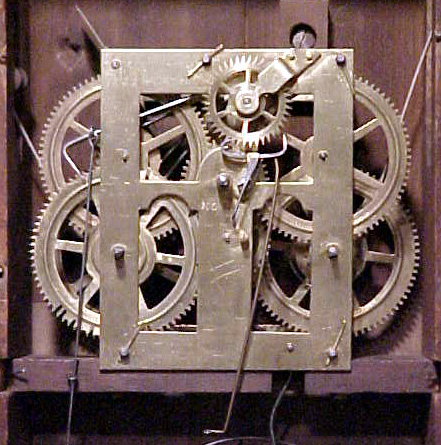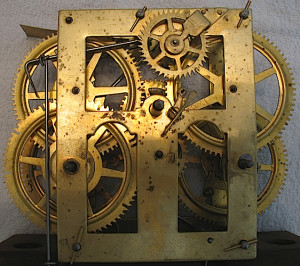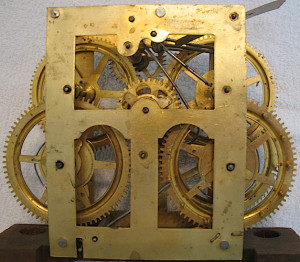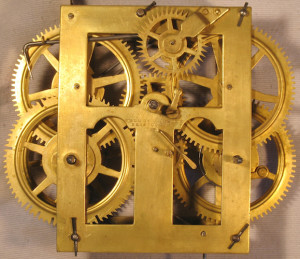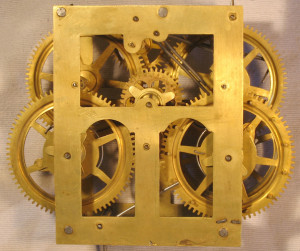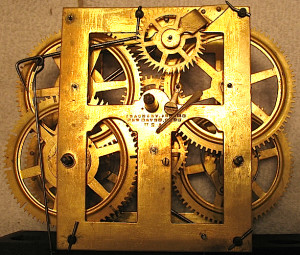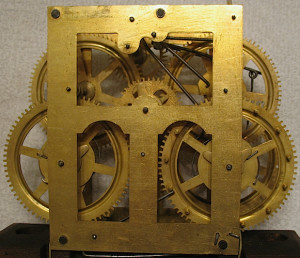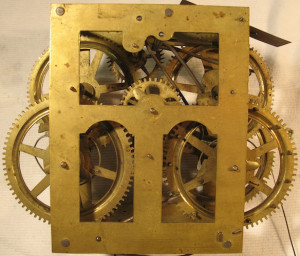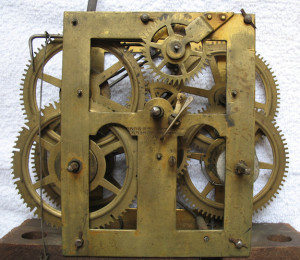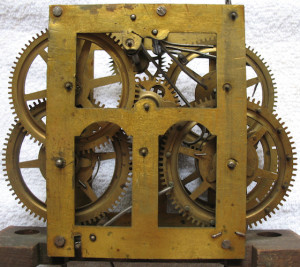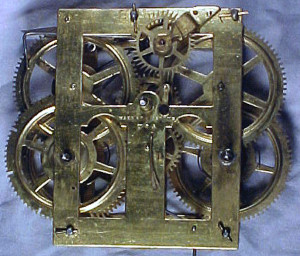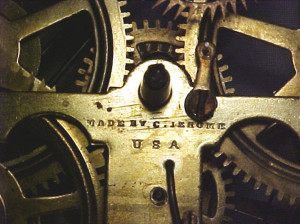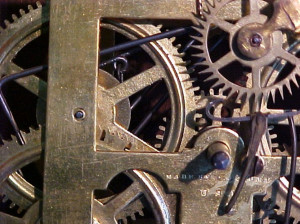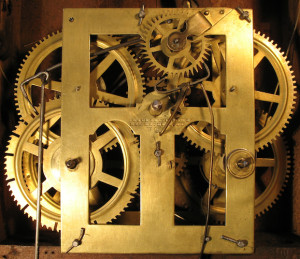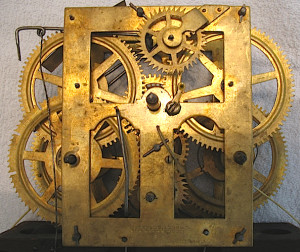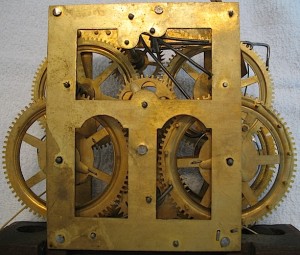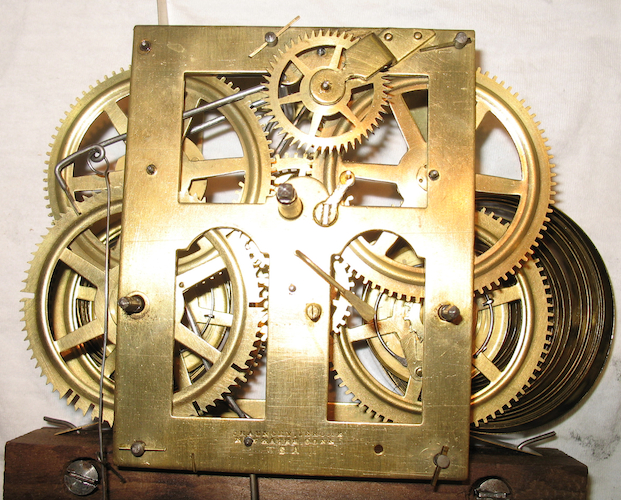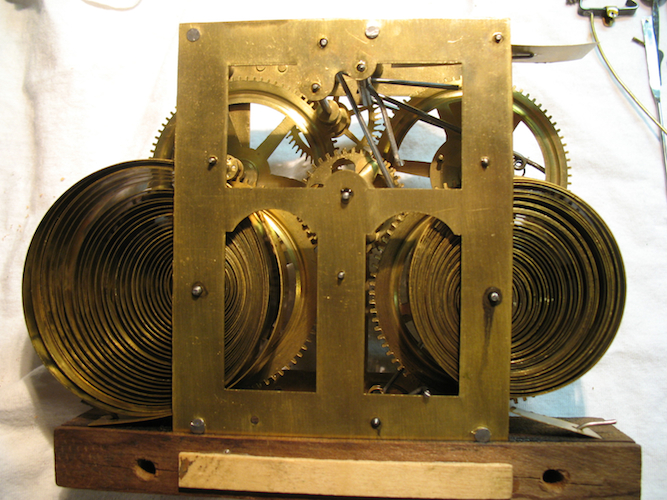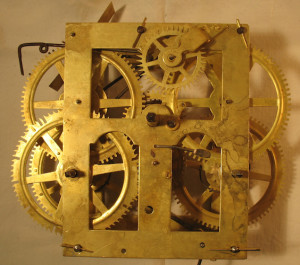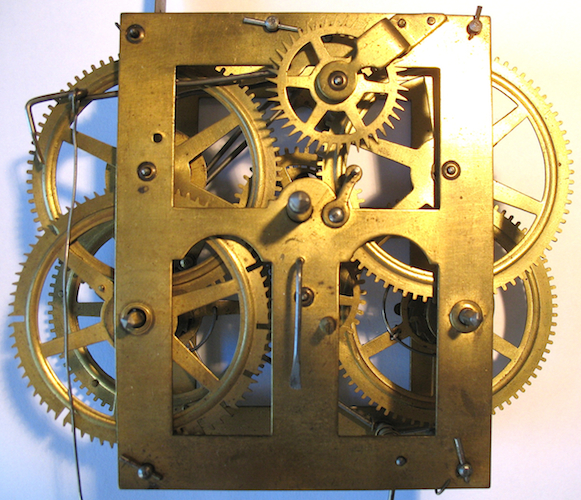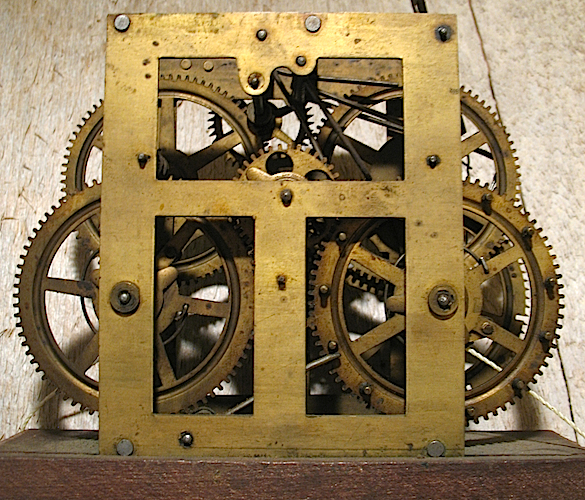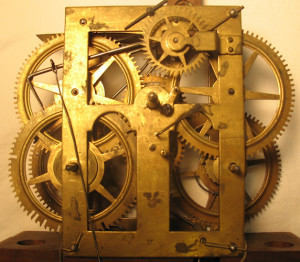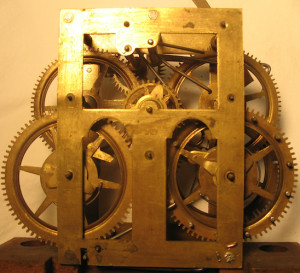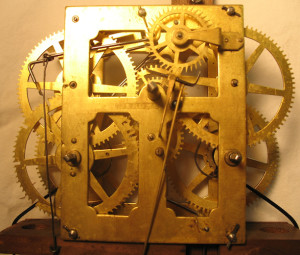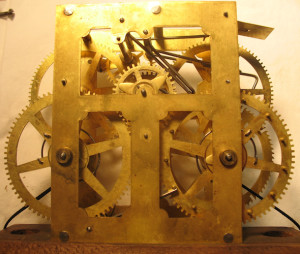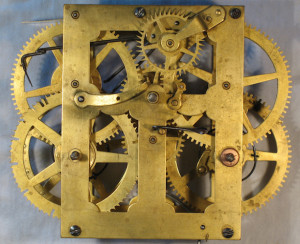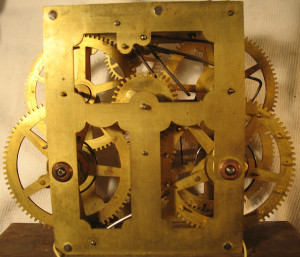30-hr brass movements based on the Noble Jerome patent of June 27, 1839 can be distinguished from one another using the identification scheme of Snowden Taylor. He was able to categorize movements based on features of the movements that were characteristic of specific makers. Originally published by the Westchester Chapter of NAWCC, it received broader distribution when published in the NAWCC Bulletin (Whole No. 221, Vol. XXIV, No. 6, Part II, December 1982). Snowden has updated the identification table over the years, but the Bulletin article remains an indispensable resource. His most recent contribution resulted in a renumbering of the earliest movements (see Watch & Clock Bull., Whole No. 403, Vol. 55/3, May/June 2013, p. 320-324). The renumbering has been incorporated throughout this website.
Many of the 30-hr movements made by Jerome and successor firms are displayed below, with notes about features that distinguish them.
Type 1.113 movement Characterized by solid brass wheels, except for the escape wheel and the number 1 strike wheel (behind count wheel). This movement closely follows the 1839 patent, aside from the spoked wheels.
Type 1.114 movement Characterized by front and back I-plates and wide, spoked wheel. Unlike the preceding movement, this was made in large numbers and probably represents the first true production model. Found in C&N Jerome; Jerome (sic), Gilbert, Grant & Co., Jeromes, Gilbert, Grant, & Co.; Jeromes & Co.; Chauncey Jerome; and L.M. Churchill & Co. labeled clocks. These movements never have a maker’s stamp.
Type 1.211 movement First of the T-plate movements, with a large, rounded boss above the horizontal bar. These movements are found in wide wheel (early) and narrow or normal wheel (later) varieties. The wide wheeled movements are unstamped, whereas the normal wheeled movements are found in serial number-stamped, C JEROME-stamped, and unstamped varieties. I have seen serial numbers ranging from 3176 to 10725. In normal wheeled movements, the C JEROME-stamped and unstamped movements tend to be later in production. The example above is a normal wheeled movement, stamped “NO 5158.”
Type 1.311 movement First use of the break-arch boss on the T-plate movement. This became the standard plate design for decades. Found in Chauncey Jerome-labeled clocks from both Bristol and New Haven, CT. There is no maker’s stamp on this movement, which is in a New Haven-labeled clock. I believe the movement dates to shortly before the fire that destroyed the Bristol factories in April 1845.
Type 1.311 movement Note that the slot in the back plate for the hammer lever is gone. I believe this change was introduced shortly before the Bristol fire. The maker’s stamp reads, “MADE BY C. JEROME/BRISTOL, CONN/USA”.
Type 1.311 movement Although still classified as a type 1.311, this version made in New Haven has some subtle differences from the Bristol version. The vertical member forming the T in the front plate is narrower in the New Haven version, and the center of the minute hand arbor is positioned slightly below the horizontal bar of the T (which bisects the arbor in a Bristol 1.311). In addition, the “humps” in the back plate for the strike levers have been reshaped.
Type 1.311 movement This is a type 1.311 with a bit of a twist. The boss over the horizontal member of the T on the front plate is not in the typical break-arch shape. Instead of having a pronounced “shoulder” on the left side, it slopes down to the horizontal member of the T (circled in red above). Although not visible, behind the verge pin arm the “shoulder” is intact on the right side. I have seen fewer than 10 examples of this movement. They typically are found in what Jerome called the “30 hour Column” model (half-column and cornice), as shown in the 1853 trade catalog. This example is a loose movement.
Type 1.32 movement At first glance, the same as the type 1.311 movement. However, the number 2 time wheel is positioned behind the number 1 wheel; the reverse of what is found in the 1.311 movement. These movements, with Bristol stamps and New Haven labels, were made for a short period c. 1844-1845.
Type 1.81 movement This is a non-standard Jerome movement that likely represents a combination of parts salvaged from the fire in Bristol, parts manufactured in New Haven, and possibly parts “bought in” from other makers. For example, the front plate is typical of Bristol movements, whereas the back plate is similar to ones made in New Haven. The stamp is unique, in that it states, “MADE BY C. JEROME/USA”. The “BRISTOL, CONN” line was ground off of the stamp, leaving the middle line blank. Unlike standard Jerome movements, which have a trip wire on the count hook, here the trip is on the drop slot lever (visible through the number 2 strike wheel in the third photo). Three have been documented to date, based on the maker’s stamp and the trip wire location. It is not known whether all of them have mismatched plates.
Type 1.312 movement The characteristic feature of this movement is the post on the vertical member of the T-shaped plate. The intermediate wheel of the motion works is mounted on this post. These movements were made at the factory in New Haven. The maker’s stamp states, “CHAUNCEY JEROME/NEW HAVEN, CONN/USA”.
Type 1.312 movement with internal alarm The winding arbor for the alarm is at 6 o’clock. The maker’s stamp states, “CHAUNCEY JEROME/NEW HAVEN, CONN/USA”.
Unclassified spring-driven movement similar to the type 1.313 movement This movement and the type 1.313 are distinguished from other Jerome movements by the strike train, where the hammer is activated by a single pin on the #2 wheel, as opposed to 13 pins on the great wheel. The single pin is visible inside the upper plate cutout in the photo on the right. The difference between this movement and the type 1.313 is that the latter has an additional pillar below the intermediate wheel. Both have 50-tooth escape wheels. This movement has its original brass springs. The maker’s stamp states, “CHAUNCEY JEROME/NEW HAVEN, CONN/USA”.
Type 1.314 movement Characterized by the first use of a rivet (instead of a screw) to secure the verge pin arm. There has also been a slight reduction in the amount of brass used for the wheels. Although this is speculation, I believe that this movement was introduced in 1851 when Hiram Camp (C. Jerome’s nephew) started making movements in New Haven for the Jerome Manufacturing Co. This company became incorporated as the New Haven Clock Co. in January 1853. In support of my belief that this movement was a product of the New Haven Clock Co., Snowden Taylor discusses the movement (although he refers to it as the type 1.313 under the old numbering system) in an article in the April 2009 NAWCC Bulletin (No. 379, page 221). In it he states that he “has long suspected that the 30-hr brass, weight movement types 1.313 and 1.4 were made there.”
Type 1.411 movement From the front, Snowden Taylor’s identification scheme doesn’t provide a means of distinguishing the type 1.411 from the type 1.314. Although I’m not certain it’s a foolproof method for distinguishing them, the plane of the curlicue on the count hook lever (for the trip wire) on the 1.411 is horizontal, whereas it’s vertical on the 1.314. Labels that accompany the type 1.411 tout the extra-bushed movement, and these bushings are usually obvious on the front plate but absent from the rear. The 1.314s are not typically extra-bushed. From the rear, the distinguishing feature is the absence of a hump on the horizontal member of the “T” on the 1.411, as well as rectangular cutouts instead of tombstone cutouts. These movements were made by the New Haven Clock Co. and were introduced after Chauncey Jerome’s bankruptcy.
Type 1.412 movement Characterized by the tapered (as opposed to necked) escape wheel bridge. These movements were made by the New Haven Clock Co. starting sometime around the late 1860s or early 1870s.
Type 2.12 movement Manufactured by Jerome & Grant, a partnership between Noble Jerome and Zelotes Grant. The business was set up with Chauncey’s assistance, with an initial contract to supply him with 40,000 movements at $1.40 each. These movements date to c. 1842-1844.
Type 2.411 movement Manufactured by the Waterbury Clock Co. when Chauncey Jerome worked for them briefly in 1856-1857 after he went bankrupt. Found in Chauncey Jerome-labeled clocks with movement stamped, “C JEROME.”
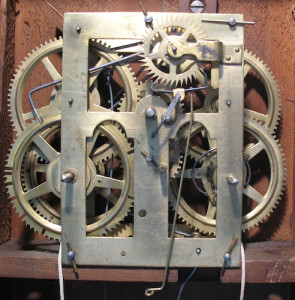
Type 2.(10)3 movement Maker unknown but found in a Crosby & Vosburgh clock, with a label claiming “successors to the Jerome Manufacturing Co.” Despite the claim, this company had no known association with Jerome, although they may have purchased inventory from the bankrupt firm.
Type 1.612 movement Made by the U.S. Clock & Brass Co. of Austin, IL. Chauncey Jerome was the superintendent of the factory in 1866-1867. These movements are found in clocks with Chauncey Jerome and U.S. Clock & Brass Co. labels.
